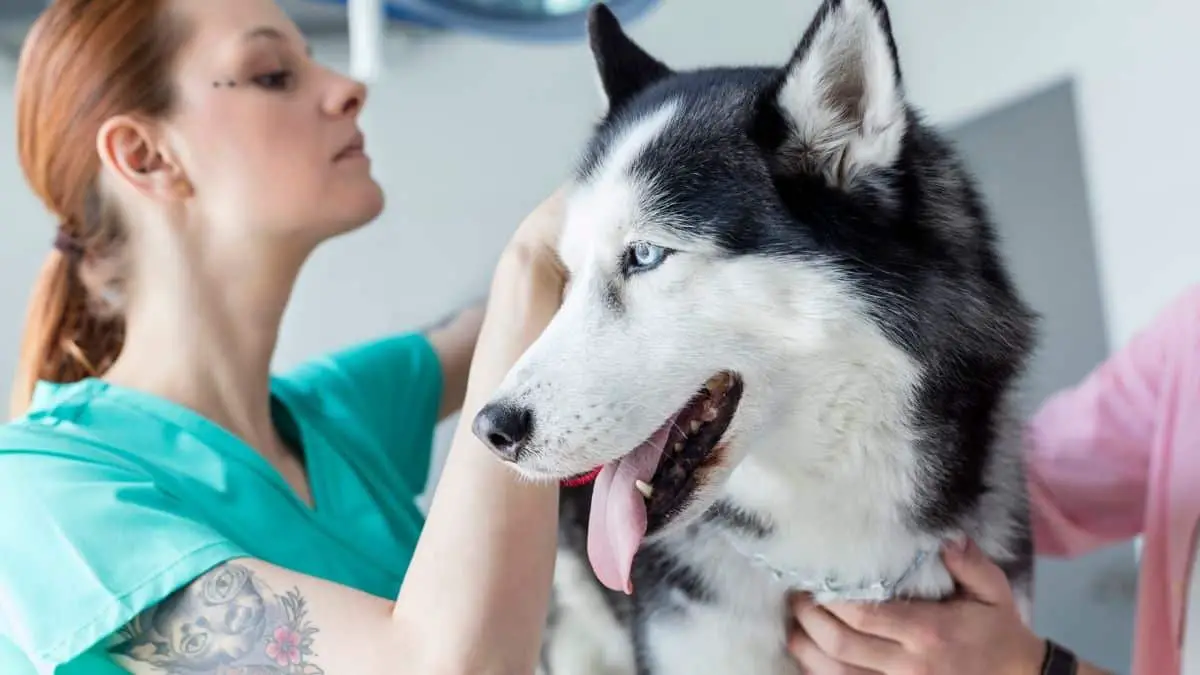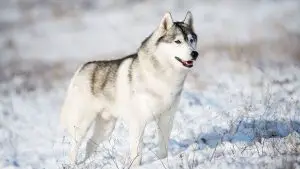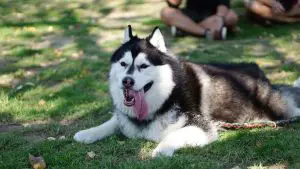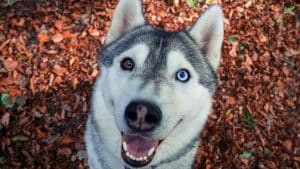Siberian Husky Health Problems & Solutions
The worst nightmare of any pet owner is discovering that your furry friend is suffering, or is unwell. As well as incurring astronomical vet bills, it can be heartwrenching to watch your dog suffer from health issues.
In comparison to other dog breeds, Siberian Huskies have relatively few health problems. This healthy breed of dog can live up to twelve to fitteen years years of age, if given proper care and attention. There are a few areas that can be concerning in relation to your Husky’s health, however. These include genetic eye diseases, hip dysplasia, issues with hair growth, and weight management.
Keeping an eye on the health of your Husky, and familiarizing yourself with any health concerns that may be lurking in their family tree will help keep your Husky healthy and happy in the long term. Huskies are strong and resilient, and often require much less veterinary intervention than other breeds of dogs if they are looked after well.
Table of Contents
Eye Disorders
If your Siberian Husky is likely to suffer from any health problem, it will likely be in relation to their eye health. Eye disorders are the most common health complaint in Huskies, and can be extremely serious.
There are several different types of eye disorders that your Husky might suffer from. These common health issues include hereditary or juvenile cataracts, progressive retinal atrophy, corneal dystrophy, and uveodermatological syndrome.
If you’re thinking that most of those issues sound like a mouthful, then you’d be right! However, as a Husky owner, it is important to get familiar with these eye disorders and ensure that your Husky’s eyes are checked by a vet on a regular basis.
Cataracts
Cataracts can begin to develop in Siberian Husky puppies as early as three months of age. These are known as hereditay, or juvenile, cataracts.
Unlike most canine cataracts, the juvenile cataracts that form on the eye of your Husky puppy are not brought on by old age. These cataracts are incredibly common, and can affect up to 10% of Huskies.
Cataracts result when there is a build up of protein film in the eyeball, which eventually deforms the eye’s lens. Cataracts can impact one eye or both eyes, and can lead to blindness if not taken care of.
Progressive Retinal Atrophy
Another doggy disorder that can impact the health of your Husky’s eyes is Progressive Retinal Atrophy (PRA). Just like cataracts, PRA can cause blindness if left undetected.
PRA involves the gradual, continual deterioration of your Husky’s retina. This is an extremely difficult and expensive issue to fix, and early detection is vital.
Corneal Dystrophy
Peculiarly, corneal dystrophy mostly affects female Huskies. Although this disorder rarely leads to blindness, it is often mistaken for cataracts.
Corneal dystrophy will appear as small white dots in the cornea. It can cause your Husky to have hazy vision. Unfortunately, there is no known cure or treatment for corneal dystrophy at this time.
Uveodermatological Syndrome
Uveodermatological syndrome can look rather alarming, and will also affect your Husky’s skin and fur as well as it’s eyes.
Although it is a relatively rare disease, uveodermatological syndrome is extremely serious, and can lead to blindness in Siberian Huskies. It involves your Husky’s immune system forming antibodies that attack it’s own light-sensing cells in the back of the eye, as well as the pigment cells in the skin.
In Siberian Huskies, the result is sore, red eyes, the loss of pigment in the face and footpads, and loss of color in the fur. These skin and fur issues are essentially cosmetic, so your vet will typically focus on the eye problems that result from uveodermatological syndrome. As this health condition can leas to permanent blindness, early intervention is crucial.
Treatments and corrective surgeries of eye problems are very expensive, and can sometimes not achieve the desired result. Prevention is the best cure when it comes to Husky eye issues, and detecting any eye health concerns while they are still in their infancy will help your Husky stand the best chance of overcoming these concerns. It goes without saying, that when you own a Siberian Husky, yearly eye checkups are a must.
Hip Dysplasia
Hip dysplasia can develop within the first two years of your Husky’s life, but is most common around middle age. With hip dysplasia, your Husky’s hip joint will be unstable or lax, commonly presenting as a loose fit of femur in the hip socket. This condition may be present in one or both hips in Siberian Huskies.
The biggest risk factor for your Husky developing this condition is his genetics. If his parents, or other close relatives in his pedigree have suffered from hip dysplasia, then it is likely that he too will inherit this painful, debilitating condition.
Hip dysplasia causes pain, inflammation, and arthritis of the hip. In the longer term, it can lead to the loss of cartilage in the hip joint, the development of scar tissue, and the formation of bone spurs in the ball and socket.
Hip dysplasia can often be exacerbated by strenuous exercise or climbing stairs. If you Husky has developed or been diagnosed with this condition, try to avoid these activities whenever you possibly can.
Although it can be hard to prevent hip dysplasia, it can be avoided through genetic testing or by buying your Husky from a breeder who can demonstrate that both parent dogs have passed the Orthopedic Foundation for Animals standards for breeding.
Keeping your Husky’s weight in check can also help prevent the onset, or reduce the symptoms of this condition.
Follicular Dysplasia
Caused by an abnormality in your husky’s hair follicles, follicular dysplasia, can either manifest as hair loss or irregular hair growth. It can affect your Husky from between three months of age, and can continue over their lifetime.
This condition is genetic, and there are no known treatments. In Siberian Huskies, follicular dysplasia will show itself in hair loss over their body, alopecia after clipping, crimping of the hair in the undercoat, and reddish discoloration of the fur (Reference: Best Undercoat Rakes for Huskies)
Given that the Husky’s double coat is one of the key ways in which they keep themselves warm and insulated in freezing weather, anything which adversely impacts the function of this double coat can impact their ability to act as working dogs.
Although there is no known cure for this illness, some vets recommend the use of topical applications, shampoos, and coat treatments.
Hypothyrodism
Abnormal levels of secretion from the thyroid gland is called hypothyroidism, and can impact Siberian Huskies. Symptoms of this condition include weight gain, bald patches and fur loss, and lethargy.
Hypothyrodism is more common in older dogs, and will see a decrease in the production of the hormone secreted by the thyroid. As this disorder occurs as your dog gets older, the signs and symptoms of this disorder can be mistaken for old age.
If you are concerned about your Siberian Husky’s behavior, and suspect that some changes to their habits or appearance could be due to hypothyroidism, have them checked out by a vet as soon as possible.
Your vet will be able to run a series of tests, including blood tests that will need to be tested in a laboratory, and will be able to diagnose your dog correctly and begin treatment.
Treatment for hypothyroidism will last for the duration of your dog’s life, and requires using a synthetic version of the hormone secreted by the thyroid .Your vet will be able to adjust this dosage as your dog progresses.
The treatment will usually take effect in a few weeks, but may need a few months to make a real impact on your Husky’s health.
Preventing hypothyroidism can be difficult. Thyroid conditions are relatively common in dogs, and vets are unable to come to a real consensus about the best means and methods of preventing this common condition. Regularly exercising your dog and keeping their weight in check may help in some cases.
Healthy Husky, happy owner
Most Siberian Huskies are all-round healthy dogs and do not require many frequent visits to the vet. Nonetheless, it is important to thoroughly check your Siberian husky’s background to find out if there have been any health problems in your Siberian Husky’s family line. As many of the most debilitating health issues that your Husky can face are genetic, this can help many major concerns in their tracks.
With that in mind, it is important to note that bringing any animal or pet into your home is a commitment that will require your time and finances to be completely invested.







